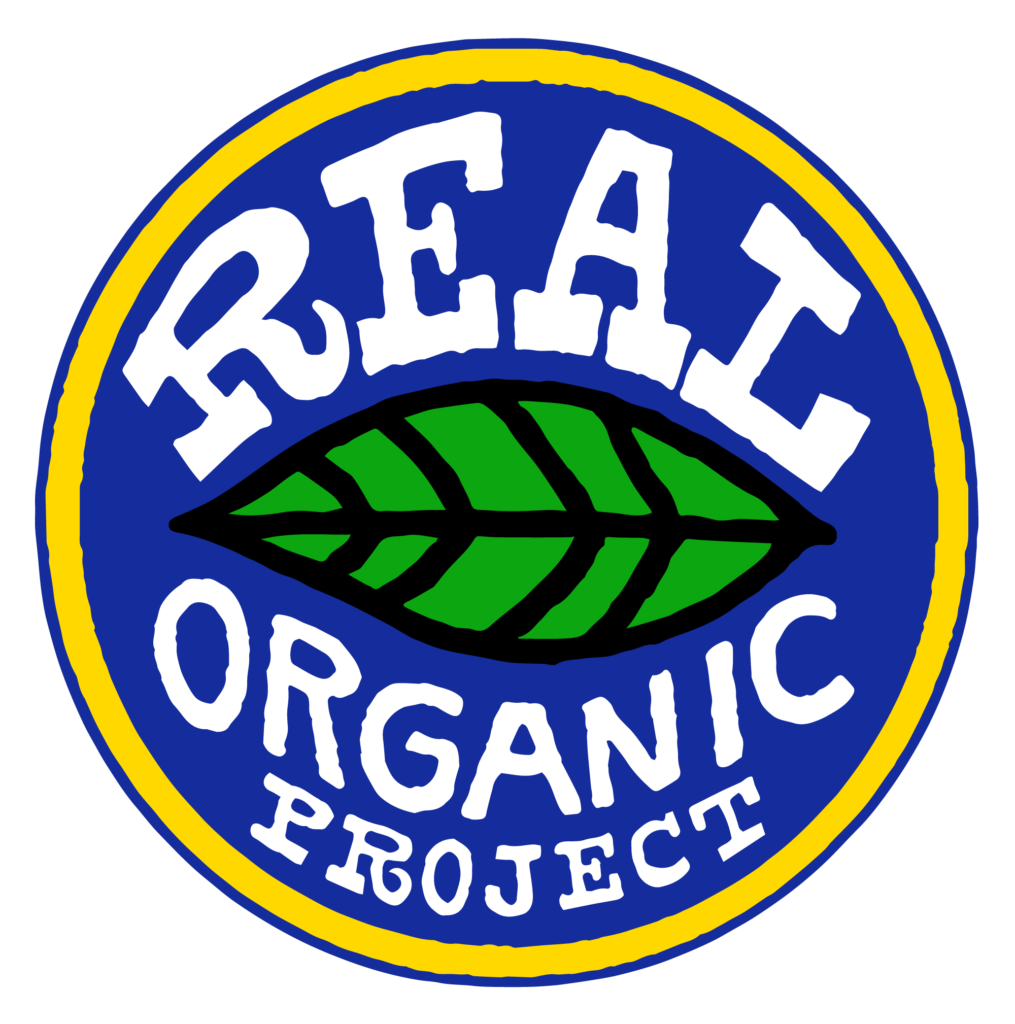A sample text widget
Etiam pulvinar consectetur dolor sed malesuada. Ut convallis
euismod dolor nec pretium. Nunc ut tristique massa.
Nam sodales mi vitae dolor ullamcorper et vulputate enim accumsan.
Morbi orci magna, tincidunt vitae molestie nec, molestie at mi. Nulla nulla lorem,
suscipit in posuere in, interdum non magna.
|
September 30th, 2013 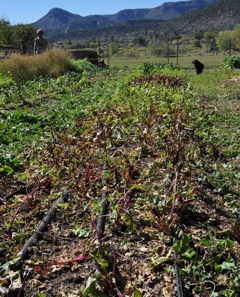
Week 15 harvest: Sweet Dumpling Winter Squash, Beets, Tomatillos, Tomatoes (red and green), Potatoes, Carrots, Garlic, Onion, Fennel
Out with the old and in with the new! We’ve spent the week pulling our hail-battered crops and planting spinach for next season. Given the shorter season and the ability to replant at the end of September, we may even get spinach this fall. Our plan is to cover the beds with low hoops and plastic to protect it until spring.
Despite pulling much of the plot, we still have a nice harvest for you this week. As you can see from the picture above, the beet greens were destroyed by the hail so the beets are smaller than they would have been given a couple weeks of extra growth. But, we’ve been enjoying the smaller size because it shortens the boiling time. Simply cut the leaves an inch above the top of the beet, leave the skin on, and boil until a fork indicates they are tender. By leaving the tops on you prevent losing all the good nutrition into the water (antioxidants like betalains, polyphenols, and fiber, potassium, manganese, folate, vitamin C, zinc, copper, and iron). The beets are delicious over a spinach and goat cheese salad (Linnea farm has wonderful goat cheese at the farmers market). The sweetness of the beets goes really well with the sharpness of the cheese.
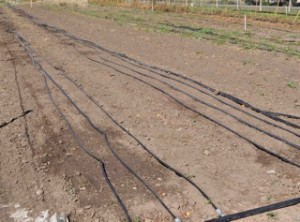
We’ve also been enjoying the winter squash. The sweet dumpling flesh is orange with thin edible skin and is loaded with vitamins, minerals and antioxidants (including carotene, lutein, omega-3 fatty acids, vitamins B2 and B6). To prepare, you can steam 1 inch cubes for about 7 minutes. Or, cut the tops off, scoop out the seed cavity, and cook them upside down in a half inch of water in the oven. Once tender, you can then prepare any stuffing to put inside the little cups (like wild rice, onion, garlic and sausage).
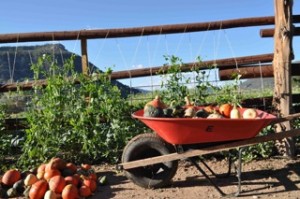
Werner here: Three years ago Denise Stovall told me about LB farm Co-op. This Co-op was formed by her and several other enterprising woman with the goal of supporting small local ranching and farming operations located on the West side of La Plata County. Since then I have been ordering different cuts of meats from them including a whole lamb and their cured ham. Since we do not sell meat, we want to provide you with the opportunity to p
urchase locally raised meat. The available cuts are listed on the attached cut sheet.
More information is available at http://www.localharvest.org/lb-farm-co-op-M42061
The contact person is Denise Stovall at 970-799-1090.
September 23rd, 2013 Week 14 harvest: tomatoes, peppers (bell, mini sweet, serrano), cucumbers, basil, parsley, kale, carrots, turnips, beets, cabbage
We hope this letter finds all of you safe after the storms of this past week. After talking to some of our friends that live along County Road 250 and our friend who lives in Boulder we consider ourselves to be overall pretty lucky. However surveying the farm on Thursday morning was difficult. As some of you have found out by now the farm was hit pretty hard last Wednesday. The crop losses are too numerous to list, almost everything that was growing above ground is gone. The leaves of our root crops and winter squash were ripped apart which will prevent them from finishing their last growth spurt. Sadly the tender strawberry plants are barely recognizable at this point. All is not lost, and while it hurts to not be able to provide you with an abundance of greens and strawberries, we still have yummy vegetables to fill your shares over the last three weeks. The root crops, winter squash, cabbage, and crops in our greenhouse and tunnels are still beautiful. We’ve decided that growing in tunnels is the only insurance against the elements and we want more of them!!
Most importantly we need to convey our thanks to everyone that has supported the farm after the storm. From those who gave us their time harvesting the damaged tomatoes, pulling plants and making trips to cold storage, to the vendors like Zia’s that provided space in their cooler, and Seasons that purchased hail damaged crops. Most significantly we need to thank Linda Illsley, of Linda’s Local Food Café who mobilized the effort to salvage what was left of our farm on Thursday and who donated her precious time and certified kitchen to help process what was gleaned. She is and will be forever in our debt. The initial shock of seeing the farm on Thursday morning was met with wonder by Thursday afternoon as more than 50 people came out to help us recover. On Friday another 25 people helped us pull plants and cut the winter squash from the vines. On Sunday and Monday, ten more arrived at Linda’s restaurant to cut and freeze the produce that will soon be turned into bloody mary mix, roasted sauces, and green tomato chutney. Despite the loss, the message from the town was clear: when local farms are in need, many people are there to help. We had the chance to meet so many people and even smile as many hands made the work less overwhelming. Now more than ever, we are so greatful to be farming in Durango.
One of our CSA members passed this recipe along saying it was the best cold soup she had ever had:
Peach and Tomato Gazpacho
- 1 1/2 lb tomatoes, chopped (4 cups)
- 1 lb peaches, pitted and chopped (2 cups)
- 1/4 cup crushed ice
- 2 tablespoons chopped shallot (1 medium)
- 2 tablespoons olive oil
- 1 1/2 tablespoons white-wine vinegar
- 1 tablespoon chopped fresh tarragon
- 1 teaspoon salt
- 1/2 teaspoon black pepper
- 1/4 to 1/2 cup water
Purée two thirds of tomatoes and half of peaches with ice, shallot, 1 tablespoon oil, 1 tablespoon vinegar, 2 teaspoons tarragon, 3/4 teaspoon salt, and 1/4 teaspoon pepper in a blender until very smooth, about 1 minute. Force through a medium-mesh sieve into a large glass measure, discarding solids. Stir in water to desired consistency. Toss together remaining tomatoes and peaches with remaining tablespoon oil, remaining 1/2 tablespoon vinegar, remaining teaspoon tarragon, and remaining 1/4 teaspoon each of salt and pepper in a bowl. Serve soup in bowls topped with tomato peach salsa.
September 17th, 2013 Watermelon Salad
- Chop watermelon & cantaloupe/ honeydew melon.
- Stack 3-5 basil, roll like a cigar and cut into strips. Toss with melon.
- Dressing: 2 tbsp virgin olive oil, 1/4 cup honey, 1/4 cup lime juice, salt to taste.
September 17th, 2013 Spanish Green Beans
- 1 onion
- 2 cloves garlic
- 1 cayenne pepper
- 1 lb fresh green beans
- 1 lb red tomatoes, chopped fine
Stir fry onions and green beans. Add garlic and peppers (don’t let garlic burn), add tomatoes and cook until green beans are tender. (Peter and I have also added a tablespoon of peanut butter and a dash of soy sauce instead of tomatoes, garnishing with peanuts at the end).
September 16th, 2013 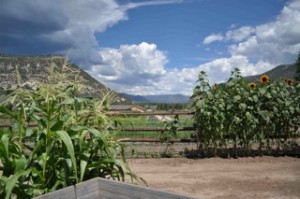 This Week’s Harvest: Root bundle (carrots, beets turnips), Zucchini, Cucumbers, Tomatoes, Yellow Onions, Kale, Salad Greens, Sweet Peppers, Hot Peppers, Eggplant, Pears This Week’s Harvest: Root bundle (carrots, beets turnips), Zucchini, Cucumbers, Tomatoes, Yellow Onions, Kale, Salad Greens, Sweet Peppers, Hot Peppers, Eggplant, Pears
Everyone who has ever visited the farm recognizes immediately that we have a killer view! I’m convinced it’s the main reason we get so much volunteer help – what incredible surroundings to work among! The thunderstorms are always fun to watch build (usually over Animas mountain as you can see above). Tonight I was watching the lightning in the clouds as I was power-washing the root veggies and it got me thinking about the future of our CSA. Last year we had the privilege of meeting the farmers of Huguenot Farm in New York, one of the most successful CSA’s in the country. They shared with me their CSA model, which includes a large u-pick section of the farm, more choice of what to bring home and an extended pick up time at the farm (they had large walk-in cooler space). They also have massive harvests averaging 13 pounds of produce per week, but there was a catch. None of it was washed. This is the price that the CSA members were willing to pay in order to free up the farmers time for growing more food. The majority of the most successful CSA’s in the country do not wash their produce. But, people sign up year after year because the of the amount of food they receive for the price.
Those of you that have been with us from the beginning know how much we are committed to farming and have improved from season to season. We are constantly striving to be better farmers – it’s practically all we think about. We depend on information from our CSA members to get us there too. So, what do you think? Would you rather have more produce and sacrifice having it washed? There’s a lot to consider. One is how much more food? Increasing the amount of food you get each week has been a main goal of ours and will always continue to be so. Our season is so short and ideally we would provide you with enough produce that you could preserve a lot for winter if you choose. Also, believe it or not, produce that isn’t washed actually lasts longer as well. But, let us know what you think next time we see you, or feel free to send us an email. We’d really appreciate the feedback as we continue to expand our growing operation.
On another note, we have PEARS this week! We have farming friends that have 11 acres of fruit trees, including pears and apples. Their orchard is spray-free and their fruit is the tastiest around. The pears are tree ripe and ready to eat when they soften over time on your counter (or in a brown bag if you are impatient). We’ll be making another visit later in the year for apples so we have that to look forward to as well!
September 9th, 2013 CSA Harvest: fennel, tomatoes (lots of beautiful heirlooms of all shapes and colors), basil, onions, root crop bundle (beets, carrots, turnips), beans, peppers (sweet and spicy), eggplant (Group A), strawberries (Group B), cucumbers, squash, dill (if you want to pickle this week), salad mix (spinach, lettuce, mizuna, baby kale), kale
Wow, the harvest list keeps getting bigger. We had a wonderful family farm dinner last night with roasted fennel and root vegetables and wanted to be able to pass that opportunity on to you. The dinner was done Dixon style: without opening a recipe book. We coarsely chopped beets, turnips, carrots and fennel, tossed it with olive oil and salt and roasted it at 300 degrees in the oven until slightly browned and tender. We also chopped some fresh tomatoes and basil and drizzled aged balsamic over them. Yum, I could eat that every meal.
We have some fresh salad greens to offer you again after a few weeks drought in that category. Finding the space to successively harvest greens to get them to you every week has been a challenge for us this year, but one we hope we can overcome next year by opening up a few more beds for greens. This week’s mix is beautiful, baby lettuce, mizuna, baby kale and spinach.
Believe it or not, our strawberries are still here – not in large numbers, but steady just the same. The alpine varieties come in late season, but they are the tastiest so that is what we like to grow. One of the greatest privileges of our farming life is to bring a few berries home to Raina at the end of the day and watch the look on her face when she sees them.
Lastly, if you get the urge to preserve some tomatoes for the winter you can always (until frost!) order a 25 lb. box for $40. That’ll make 12 quart jars of sauce or 6 quart jars if you decide to strain the liquid. Freeze some basil, onions and peppers to add when you open the jars and it’ll be better than anything you find in the store. Please don’t hesitate to ask if you have any questions about how we go about canning our tomatoes, it’s not as daunting as it seems. See you tomorrow!
September 2nd, 2013 This week’s harvest: Tomatoes (5 lbs!!), Basil, Chard, Kale, Cucumbers, Dill, Zucchini, Peppers, Carrots, Onions, Eggplant, Green Beans
It’s CSA week 11 and we’re in the midst of peak season. My east coast farming friends have been experiencing the bounty for months, but here in Durango with our cold nights all summer long, we finally get a few weeks of surplus before frost arrives!
Despite our late start on the new plot and the early season hail scare, the tomatoes are coming in strong. You’re getting 5 pounds this week – enough to can 2 quart jars if you don’t want to eat bruschetta every night (although I could). To cope with the excess we’re providing instructions below for canning your tomatoes, zucchinis and cucumbers. Of course you can always freeze tomatoes and zucchinis, but to preserve the best flavor and save on freezer space, canning is the way to go. If you’ve never tried it, don’t be intimidated, it really can be quite simple. Both the recipes below do not require a pressure canner.
If you decide you’d like to preserve a lot more for winter, we’ll bring a few extra 25 lb boxes of tomatoes to sell tomorrow at a discounted price ($40 for a 25 lb box is $1.60 per pound, first come first serve). 25 lbs make 12 quart jars. If you miss out tomorrow, let us know you’d like to buy a box and we’ll arrange to bring it next week or for you to pick it up at the farm. The same deal holds for cucumbers and zuccinis as well ($1 per pound), so please let us know if you’d like our CSA member discount on large volumes of these crops.
Canned Tomatoes (this is a recipe if you don’t have a pressure canner):
- Quarter your tomatoes and plop them in a big pot over medium heat for 30 minutes, stirring occasionally. Add basil the last 10 minutes if you like.
- Pour the sauce into a quart jar (wide rims are easier). Be sure to leave 1-inch space from the lid.
- Add 3 Tablespoons of lemon juice (this is optional, but provides extra precaution that the tomatoes are acidic enough to prevent microbes from growing).
- Wipe the rim free of any drips with a clean paper towel and screw on the top.
- Place in a pot of boiling water (water should come 1 inch over the top of the jar). Boil for 45 minutes. Remove from the water and let cool on the counter. After the jars cool, double check that the lids are suctioned down and don’t pop when you push on them. Always re-check seal before eating throughout winter.
Pickles
- Slice cucumbers or zucchinis lengthwise.
- Combine 1½ quarts vinegar, ½ cup salt, ¼ cups sugar, 2 quarts water and bring to a boil on the stove (use a non-metal or coated metal pot since the metal reacts with the vinegar and makes the solution go cloudy).
- Fill quart jar with cucumbers, 2 teaspoons mustard seed and dill (with dill heads). You can also add garlic and peppers.
- Pour hot liquid in jar until 1 inch from the top. Screw down top.
- Place jars in boiling water (1 inch over the top) for 25 minutes (again we are over 6,000 feet so the boiling time is longer).
- Remove jars and let cool on counter. Check seal (you can refrigerate and eat within 2 months if not sealed).
August 26th, 2013 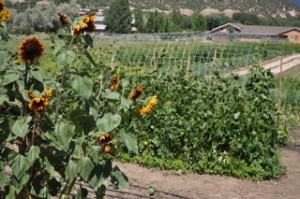 This Week’s Harvest: Tomatoes (2 lbs), Basil, Chard, Kale, Parsley (Italian Flat Leaf), Cucumbers, Dill, Zucchini, Serrano Peppers, Carrots, Turnips, Onions… And, Green beans, in my opinion a most delicious vegetable! This Week’s Harvest: Tomatoes (2 lbs), Basil, Chard, Kale, Parsley (Italian Flat Leaf), Cucumbers, Dill, Zucchini, Serrano Peppers, Carrots, Turnips, Onions… And, Green beans, in my opinion a most delicious vegetable!
This is Werner, the one and only non-Dixon Adobe House farmer! I am writing this message because I like green beans. Green beans are the unripe fruit of various cultivars of the common bean and a tender vegetable. Beans, when grown to ripeness and dried, are the hard seeds requiring hours of cooking to soften them. These hard beans, because of their long storage life and high protein content, are a staple in many societies. Adobe House Farm only grows pole and bush beans. Also known as string and snap beans, they come in many different shapes, colors and sizes. In my opinion, they are undervalued as a veggie and are best and most tender when grown in a home garden or when provided fresh from a CSA.
Because I like pole beans, we grow a limited amount of them. Pole beans want to climb up poles, strings or up a trellis. The variety I like best is Fortex, similar to Kentucky Wonder. Pole beans, in difference to bush beans, grow longer and bigger, are slower to produce, yet keep on providing until frost – assuming they are being picked regularly. Know that even a long one is still tender when cooked. Bush beans, on the other hand, are faster producing, yet stop having new flower buds and peter out. The “bushes” are about a foot tall. We grow green and yellow varieties, with the later much easier to find, which makes the time consuming process of picking them a little easier.
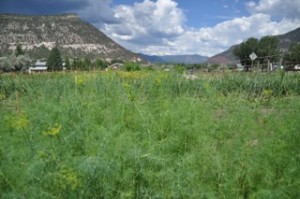 Pole or bush beans can be eaten raw, yet are most often cooked in water or steamed and best when still firm with butter and herbs added last. It’s a shame to overcook this delicious vegetable so that it ends up soft and, in my opinion, yucky. Yet, they can also be cooked in a frying pan with some water (most or all of it boiled off), a little butter or oil and garlic, yet one has to watch to make sure they do not get burned. When still hot I like to add some vinegar and herbs giving them the flavor of a bean salad without all the oil and vinegar, while extending their shelf life in the refrigerator. Pole or bush beans can be eaten raw, yet are most often cooked in water or steamed and best when still firm with butter and herbs added last. It’s a shame to overcook this delicious vegetable so that it ends up soft and, in my opinion, yucky. Yet, they can also be cooked in a frying pan with some water (most or all of it boiled off), a little butter or oil and garlic, yet one has to watch to make sure they do not get burned. When still hot I like to add some vinegar and herbs giving them the flavor of a bean salad without all the oil and vinegar, while extending their shelf life in the refrigerator.
Enjoy the treat of fresh and tender beans!!! – Werner
Spanish Green Beans
- 1 onion
- 2 cloves garlic
- 1 cayenne pepper
- 1 lb fresh green beans
- 1 lb red tomatoes, chopped fine
Stir fry onions and green beans. Add garlic and peppers (don’t let garlic burn), add tomatoes and cook until green beans are tender. (Peter and I have also added a tablespoon of peanut butter and a dash of soy sauce instead of tomatoes, garnishing with peanuts at the end).
A few other ideas to use your produce
- hang the dill bunch upside down in your kitchen and let it dry. Use as needed (or let it be a decoration all winter)
- parsley and cous-cous salad with your tomatoes and cucumbers
- preserve your zucchinis by canning – there are lots of recipes online
- refrigerator pickles will use up your cucumbers, dill, serrano, and garlic and no need to pressure can.
August 19th, 2013 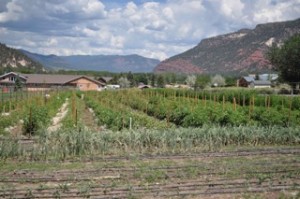 This week’s harvest: eggplant (Group B), green beans (Group A), carrots, turnips, beets (try roasted root veggies, yum), chard, kale, dill, cilantro, basil, zucchini, tomatoes, onions, and cucumbers. This week’s harvest: eggplant (Group B), green beans (Group A), carrots, turnips, beets (try roasted root veggies, yum), chard, kale, dill, cilantro, basil, zucchini, tomatoes, onions, and cucumbers.
Hello everyone, Peter here, giving Linley a break from the rigors of writing our CSA letter for week 9. We are officially half way through the CSA season and I’m 60% sure I’ve memorized 87% of everybody’s names. I have really enjoyed my weeks managing the CSA pickup at Linda’s Café. Being somewhat of a farming/daddy-daycare hermit my first few years in Durango it has been a treat meeting everyone, sharing recipes, and talking about the farm. This has easily been the most rewarding year of farming for me on a personal level and I believe it’s directly related to my increased interactions with our diverse CSA community. I think it’s very important for a farmer’s well being to know and interact with their customers. 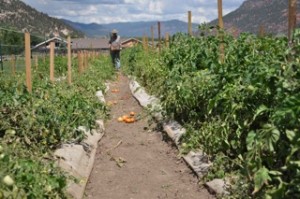 Coming from a fisheries background with no knowledge of growing I was happy the first couple of years sequestered on the farm following Linley’s directives, knowing in theory our goal and mission to provide local organic veggies was worthwhile. However my increased role in the exchange and hearing the (so far) positive feedback has driven home the fact that I really do enjoy growing food for people. While I would trade the heat and dirt in a second to be back underwater, I wouldn’t trade the smiles on your faces at CSA pickup for anything. Thank you! Coming from a fisheries background with no knowledge of growing I was happy the first couple of years sequestered on the farm following Linley’s directives, knowing in theory our goal and mission to provide local organic veggies was worthwhile. However my increased role in the exchange and hearing the (so far) positive feedback has driven home the fact that I really do enjoy growing food for people. While I would trade the heat and dirt in a second to be back underwater, I wouldn’t trade the smiles on your faces at CSA pickup for anything. Thank you!
This weeks recipe: SALT (in moderation of course)
Sometimes we get caught up in finding recipes for how to use/prepare all of the veggies from the farm and forget that this stuff tastes pretty good all on its own. Don’t get me wrong, I love the recipes we’ve put out as well as the ones you’ve all shared with us but sometimes simple is good. So I’ve got two simple ones to share with you this week, both of which my mom made for me while growing up in the Midwest.
Take your tomato and slice it thick. Pick a salt: Himalayan pink salt, Hawaiian sea salt, or maybe just plain old kosher salt and grind some (lots) peppercorns on top. Add a leaf of basil or dill if you’re feeling particularly adventurous. Eat.
Slice your cucumbers. Spread peanut butter (or almond butter, sunflower butter, tahini) on your favorite cracker (we used Ritz). Place the cucumber slices on top of the cracker and then finish with your favorite seasoned salt. Eat.
August 17th, 2013 Canned Tomatoes (this is a recipe if you don’t have a pressure canner):
- Quarter your tomatoes and plop them in a big pot over medium heat for 30 minutes, stirring occasionally. Add basil the last 10 minutes if you like.
- Pour the sauce into a quart jar (wide rims are easier). Be sure to leave 1-inch space from the lid.
- Add 3 Tablespoons of lemon juice (this is optional, but provides extra precaution that the tomatoes are acidic enough to prevent microbes from growing).
- Wipe the rim free of any drips with a clean paper towel and screw on the top.
- Place in a pot of boiling water (water should come 1 inch over the top of the jar). Boil for 45 minutes. Remove from the water and let cool on the counter. After the jars cool, double check that the lids are suctioned down and don’t pop when you push on them. Always re-check seal before eating throughout winter.
Pickles
- Slice cucumbers or zucchinis lengthwise.
- Combine 1½ quarts vinegar, ½ cup salt, ¼ cups sugar, 2 quarts water and bring to a boil on the stove (use a non-metal or coated metal pot since the metal reacts with the vinegar and makes the solution go cloudy).
- Fill quart jar with cucumbers, 2 teaspoons mustard seed and dill (with dill heads). You can also add garlic and peppers.
- Pour hot liquid in jar until 1 inch from the top. Screw down top.
- Place jars in boiling water (1 inch over the top) for 25 minutes (again we are over 6,000 feet so the boiling time is longer).
- Remove jars and let cool on counter. Check seal (you can refrigerate and eat within 2 months if not sealed).
|
Contact AHF (970) 317-0309
linley@adobehousefarm.com
|








